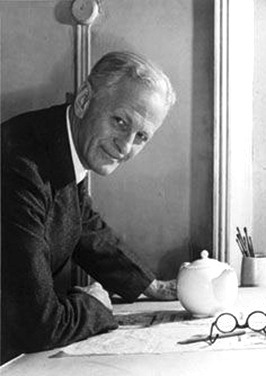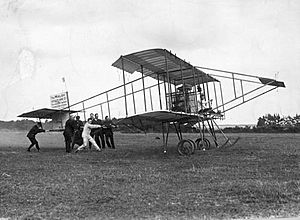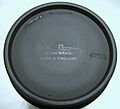Keith Murray (ceramic artist) facts for kids
Quick facts for kids
Keith Murray
|
|
|---|---|

Keith Murray at work
|
|
| Born | 5 July 1892 Mount Eden, Auckland, New Zealand
|
| Died | 16 May 1981 (aged 88) Dorset, England
|
| Occupation | Architect |
| Spouse(s) | Mary Beatrice de Carteret Malet (m. 1948) |
| Children | 1 |
| Practice | Murray & White Ramsey, Murray & White Ramsey, Murray, White & Ward Murray, Ward & Partners |
| Buildings | Wedgwood factory, Barlaston (1940) BEA hangars, London Airport (1953) Terminal building, Hong Kong Airport (1962) |
Keith Day Pearce Murray (5 July 1892 – 16 May 1981) was a famous architect and industrial designer. He was born in New Zealand but later became a British citizen. He is best known for his amazing designs of pottery, silver, and glass. He created these for companies like Wedgwood, Mappin & Webb, and Stevens & Williams in the 1930s and 1940s. Many people consider him one of the most important designers of the Art Deco and Modern design eras.
Contents
Early Life and Education
Keith Murray was born in Mount Eden, a suburb of Auckland, New Zealand, on July 5, 1892. His father, Charles Henry Murray, was from Scotland. His mother, Lilian Day George, was from New Zealand. Keith's father passed away when Keith was young. Later, his mother remarried.
Keith went to Prince Albert College in Auckland. When he was 13, his stepfather had to study medicine in Scotland. So, in 1906, Keith and his family moved to Britain. There, he attended Mill Hill School in London. In 1907, they returned to New Zealand. Keith then went to King's College and passed his university entrance exams.
A Career Takes Flight
Starting in Architecture and Aviation
Around 1910, Keith Murray started working as a designer for an architect in Auckland. At the same time, he became the secretary for the new Aero Club of New Zealand. This club was very important for early aviation in the country.
The club even hosted famous aviation pioneers like Alexander Graham Bell. Keith helped promote early airplanes and the club's activities. He even designed the club's special winged badge. He also designed a glider for a club competition and won second place! He worked as an architect until 1914, when he moved to England to study architecture more.
Serving in World War I
During World War I, Keith Murray became an officer in the Royal Flying Corps (RFC) and later the Royal Air Force (RAF). He learned to fly in 1915. He was sent to France in December 1915 for observation and scouting missions.
He quickly moved up the ranks, becoming a flight commander and then a major. He commanded No. 10 Squadron RAF, flying Armstrong Whitworth F.K.8 planes. His squadron took part in important battles like the Battle of Cambrai in 1917. He said his pilots liked their planes for their scouting jobs, even if they were slow.
Keith was recognized for his bravery several times. He received the Military Cross in September 1917. This award was for his "conspicuous gallantry and devotion to duty." He flew very low, even under heavy enemy fire, to help guide his army's cannons. His plane was often damaged, but he always succeeded. After the war, he also received the Belgian Croix de Guerre.
After the war, Keith returned to London to continue his architecture studies.
Becoming a Top Designer
Keith Murray finished his architecture studies in London in 1921. He became a member of the Royal Institute of British Architects. However, there wasn't much architecture work available then. So, he started working as an illustrator for magazines.
He visited important design exhibitions, like the 1925 Paris Exposition. These inspired him to design vases and tableware for factories. As the Great Depression hit in the early 1930s, there was even less demand for architects. So, Keith decided to become a full-time designer.
In 1932, he started working as a freelance designer for Stevens & Williams, a glass company. He created over 1200 designs for them between 1932 and 1939.
That same year, he also began working for Josiah Wedgwood and Sons, a famous pottery company. Josiah Wedgwood V invited him to visit their factory. Keith was hired to design dinnerware and teaware. This is where his famous ribbed designs became popular. His first collection was called 'Annular'.
In 1934, Mappin & Webb, a royal silversmith company, asked him to design silver bowls and vases. He used similar ideas to his Wedgwood designs.
Most of Keith's designs were for vases, bowls, and other round items. They had a clean, simple style. Often, the only decoration was deep lines or smooth steps in the shape. The pieces were usually one color with no added patterns. From the start, his designs were so well-known that his signature was placed on every piece, right above the Wedgwood mark.
In 1935, he helped design glassware for the new Orient Line ship, the RMS Orion. The next year, Keith was chosen to design the new Wedgwood factory in Barlaston, Staffordshire.
World War II and Later Architecture
In 1939, just before World War II started, Keith Murray returned to the Royal Air Force. He served as an officer in an administrative role. He had to leave the service in 1942 due to health issues. He was again recognized for his service in the 1942 New Year Honours.
After the war, he went back to working as an architect and stopped industrial design. Keith Murray's designs were very popular during his lifetime. Today, his work is still highly valued and sought after by collectors.
Images for kids








